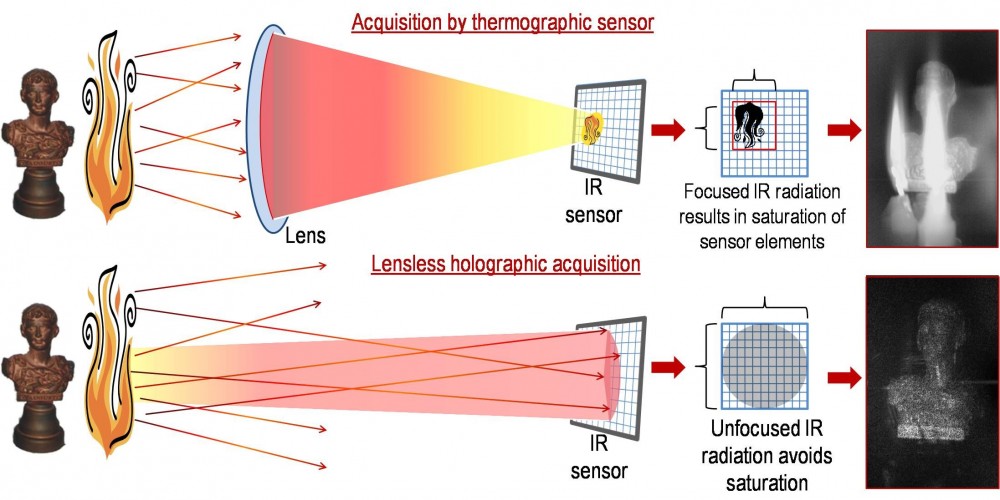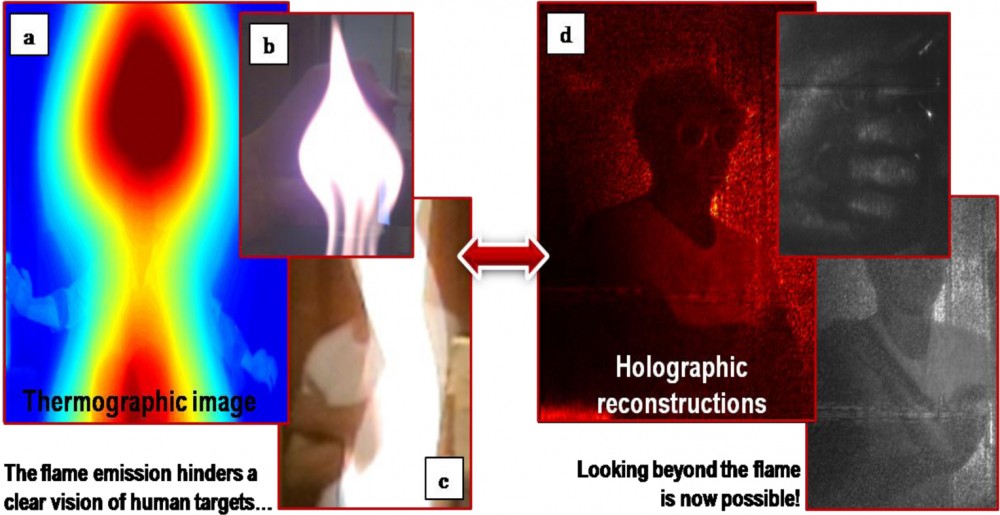Infrared digital holography allows firefighters to see through flames
February 28, 2013

To see through smoke, scientists employ lenses to collect and focus light, but using the same technique with flames results in saturation in some areas of the resulting image (top). The new system does not employ a lens, so collected light is distributed over the whole array of camera pixels, avoiding this saturation and the blind spots it produces (bottom). (Credit: Optics Express)
Other applications could include monitoring breathing, cardiac beat detection and analysis, body deformation measurements during exercise
One of their greatest challenges for firefighters is seeing through thick veils of smoke and walls of flame to find people in need of rescue. So a team of Italian researchers has developed a new imaging technique that uses infrared (IR) digital holography, described in a paper published today in the Optical Society’s (OSA) open-access journal Optics Express.
Firefighters can see through smoke using current IR camera technology, but are blinded by the intense infrared radiation emitted by flames, which overwhelm the sensitive detectors.
“IR cameras cannot ‘see’ objects or humans behind flames because of the need for a zoom lens that concentrates the rays on the sensor to form the image,” says Pietro Ferraro of the Consiglio Nazionale delle Ricerche (CNR) Istituto Nazionale di Ottica in Italy. By eliminating the need for the zoom lens, the new technique avoids this drawback.
It also allows for a holographic recording of a live person, even while the body is moving.”
How it works

Two images of a live human subject as seen through flames. When viewed in infrared or white light, the man is almost completely occluded (left). The new system reproduces the image behind the flames using holography, revealing a man wearing a t-shirt and glasses (right). (Credit: Optics Express)
Holography is a means of producing a 3-D image of an object. To create a hologram, such as those typically seen on credit cards, a laser beam is split into two (an object beam and a reference beam).
The object beam is shone onto the object being imaged. When the reflected object beam and the reference beam are recombined, they create an interference pattern that encodes the 3-D image.
In the researchers’ new imaging system, a beam of infrared laser light is widely dispersed throughout a room. Unlike visible light, which cannot penetrate thick smoke and flames, the IR rays pass through largely unhindered. The IR light does, however, reflect off of any objects or people in the room, and the information carried by this reflected light is recorded by a holographic imager. It is then decoded to reveal the objects beyond the smoke and flames. The result is a live, 3-D movie of the room and its contents.
The next step in moving this technology to the field is to develop a portable tripod-based system that houses both the laser source and the IR camera. The systems may also be suitable for fixed installation inside buildings or tunnels. In addition, the team is exploring other applications, including non-destructive testing of large aerospace composite structures.
It could also record dynamic scenes of a human body for studying or monitoring breathing, cardiac beat detection and analysis, or measurement of body deformation due to various stresses during exercise, Ferraro says.